
A Cave of Candles / by Dorothy V. Corson

Chapter 11
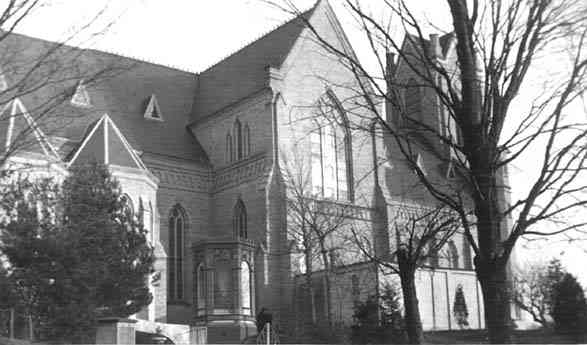
New Evidence of Sorin's Original Grotto
Locating the origin of the black stones had proven the value of retracing the first steps of my research. Now it was drawing me back to the University Archives to go over again, whatever references I might have missed the first time around.
My first step involved the further attempt to confirm the rest of Father Maguire's statements in his letter of correction. I decided to concentrate on what appeared to have been an earlier Grotto built by Sorin in the 1870s. Perhaps with a more concentrated effort, I could prove or disprove its existence. The references to "Sorin's Grotto" kept reappearing in countless articles and in several it was mentioned that it took 18 years and was completed in 1896. Since I'd found evidence the present Grotto took only three months to build I knew I was going to have to clarify, if and when, Sorin built a Grotto and whether it was ever completed and dedicated.
This time I tackled the Scholastics from the first mention of his plan to build a Grotto up to the present one built in 1896. I started with 1873, checking each subsequent issue for the Feast of Assumption date when pilgrimages were made yearly to the Portiuncula Chapel before there was any mention of Sorin building a Grotto.
In an 1877 Scholastic, I was surprised to find this evidence of an early Grotto at St. Mary's even before any mention of Sorin's:
There are already three representations of the Grotto in the United States, one at the House of the Sisters of Notre Dame in St. Aloysius parish in Washington, D.C., one at the House of the Sisters of Charity at Yonkers, and one at St. Mary's at Notre Dame, IN.(83)
As I got nearer to the 1878 date there were a few more mentions of work in process until finally, in the one and only mention of it, I found its dedication on the August 22, 1878.(84) Sorin had indeed completed and dedicated a Grotto and it appeared to have been very near the present one. But why no pictures and no descriptions other than the mention of this first pilgrimage to the Grotto which culminated at the church?
On the same day Sorin's Grotto was dedicated, it was also reported that a visitor, Miss Mary Regina Jamison of Wheeling, West Virginia, had made a visit that day to Notre Dame and St. Mary's. She reported:
The facsimile of the Grotto of Lourdes at St. Mary's Academy comes nearer the original than any that she has seen in either this country or in Europe. Miss Jamison resided for some time at Lourdes, during a tour made by her to Europe, and of course her opinion carries much weight.(85)
My curiosity was immediately aroused. If she had seen both Grottoes and pronounced the St. Mary's Grotto as the closest replica to Lourdes in United States or Europe then what had the first Sorin Grotto looked like and why hadn't she mentioned it? And why was the Sorin Grotto replaced eighteen years later with the now closer replica to the one at Lourdes?
Two days before the 1896 dedication date the Scholastic reports:
Removal of tower-like niche which sheltered Blessed Virgin on site of old Grotto was effected, after the statue had been placed in the new Grotto. When statue was taken away the niche meant nothing and was a disfigurement.(86)
If the statue fit in the new Grotto then the old Grotto niche must have been similar in size to the present one. I wondered why there were no pictures of it. I continued to note each pilgrimage to the Sorin Grotto from its dedication in August of 1878 until the beginning of the work on the 1896 Grotto finding no more evidence than already unearthed.
Then, in thumbing through the Scholastics randomly, I stumbled upon an article I had not found earlier because it had not been indexed when it was done by the WPA during the depression. It was entitled: "Where Peace Is" under a section called, "Silhouettes and Sketches." It referred to Sorin's gardens in back of the presbytery, how the quiet was being disturbed, in part:
Morning and evening the little plot and all it holds within its hedge of evergreens are steeped in shade; it is only when the sun is high in the heavens that the delicate tracery of the willow branches, instinct with grace, is etched in darker greens upon the sun-kissed sod. Yet the grass is always virid and healthy: in March its translucent scimitars flash out of their earth-scabbards before the passing of the snow; and in mid-summer, when lawn and pasture have lapsed to a neutral joyless brown, here tree and shrub and flower are as quick and blithesome as though it were April and they had but just felt the first burst of Spring's alchemist power.
Until the workmen came with picks and shovels, a month or two ago, to chop in its lower edge a niche for the new Grotto of Lourdes, the garden was quiet as the village of Goldsmith's love.
Further on it continues with its revealing description:
Once upon a time the ground sloped down from the west wall of the church to the water's edge, thirty yards distant; and after the garden was planned, it took many tons of earth to build the broad terrace for Father General and the work grew apace. Then came the great fire and the plot was suddenly widened. The lake was driven backward.(87)
It was a small reference, but somehow for some reason it pleased me to have run across it so fortuitously. When I reached the end of the article and found the following initials at the bottom of it, D.V.C. -- the same as my own and not a usual combination -- somehow, I felt I was on the brink of new discoveries.
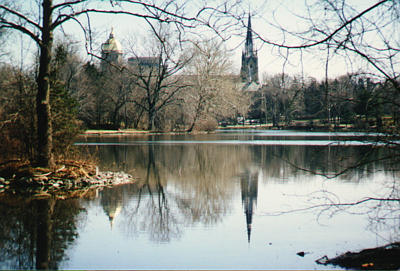
Finally a Breakthrough
I was due for lunch with a library friend I had met during my research. Peter Lysy not being close at hand, I marked the page and left it on the counter with a message that somehow I felt this was like an arrow pointing to what I'd been looking for. As I left, I asked Sharon if she'd mention it to him while I was gone.
An hour later, I returned to find Peter had read the article and recalled another folder of interest which he had laid out for me. With it were two other articles from the Columbian Jubilee Celebration in 1892, items which I hadn't come across before. One contained an interesting walking tour describing the grounds in 1886, "when there was but one lake" including the path from Columba Hall toward the church. I include the lake description, as this has always been a topic of conversation whether it had once been one lake or had always been two.
Here two lakes, fed by never-failing springs, discharge their crystal waters into the river by a westerly flowing rivulet. These lakes were originally surveyed and mapped as one, but the land between them, now dry, was never covered by any depth of water, and in after years its marshy exhalations causing ill health, it was deemed advisable to introduce a system of drainage which converted the original single lake into two, of which the larger covers about 25 acres, the smaller 17. A rising ground between the lakes is still known as the 'Island.'
Almost directly opposite the Novitiate is the Professed House, for the religious of Holy Cross. This building, or rather series of buildings, connected together, stands midway between two lakes upon an eminence which was formerly an island in the midst of a large sheet of water -- when some thirty or more years ago there was but one lake. For a long time, even after the improvements made by skillful drainage making it two lakes, it was known as 'the Island;' but a few years ago a name was given to it, to immortalize the career and active service of good old Brother Vincent -- the oldest living member of the Congregation of Holy Cross, and the best part of whose life has been given to the service of Notre Dame -- and it is now known as Mt. St. Vincent.' Here reside the members of the order whose duties do not require their constant presence at the university.
As we leave the Seminary grounds and turn eastward toward the University, our path lies along the shore of St. Mary's Lake, on the opposite bank of which we see the barns, stables, and numerous small buildings that constitute the 'home center' of the great farm.
Our path has now led us to the foot of a little hill, and we are agreeably surprised, as we are brought face to face with a facsimile representation of the Grotto of Lourdes, beautifully sculptured out of the side of the declivity. The rocks are there portrayed, while underneath is the gurgling fountain. To one side, lifted on high, is a beautiful statue of Our Lady of the Immaculate Conception, encased in an octagonal frame, the sides of which are glass, supported by stone pillars. At a little distance is the kneeling figure of Bernadette, in her quaint, pleasing Breton dress, praying to the Virgin of the Apparitions. To the left of this lovely spot is a square, three-story building -- the residence of Very Rev. Father General Sorin and his assistants. It is the mother house of the entire Congregation of Holy Cross -- the great center whence issue those directions that regulate the affairs of the order extended over the world. Such are some of the principal features of Notre Dame -- the Pride of the West . . . .(88)
This octagonal building description of Sorin's 1878 Grotto, in turn, registered on Peter Lysy as being classified as a building. He had pulled the Sanborn maps of the 1880s, drawings of the buildings on the campus for fire insurance, to see if there was a record of it. We were pleased to find in the corner of the church and sacristy a small circle labeled -- Grotto. He then explained that only buildings were noted on the Sanborn maps and that a cave-like Grotto such as the present 1896 Grotto would not have been noted on them.
We now began to pour over pictures of the church and presbytery along with an additional one found in Thomas Schlereth's 1976 book(89) about the history of the campus. In it, were photographs from the 1880s showing pictures of the church and presbytery before the chapels were added. One seemed to show vaguely the top of an odd shaped building which before had not garnered any attention. Puzzled we both viewed the picture more thoroughly. Could this be the octagonal building referred to in the Jubilee article? If so, it was not directly west of the presbytery where the present Grotto was, but south of it, just ten feet or so from the present sacristy steps. Unfortunately, the photo was too vague even with a magnifying glass to see it in detail.
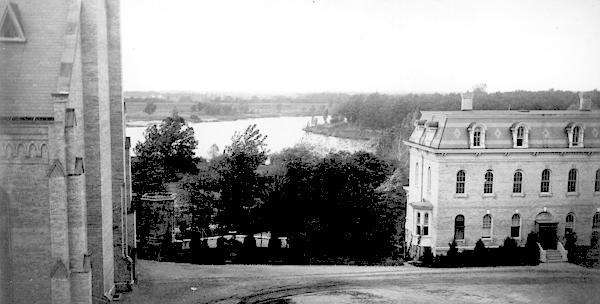
Both of us were feeling we were making steady progress. Peter disappeared again and returned with another file, in which, low and behold, was a large photograph(90) of the front of the Sorin Grotto. It was dated, November 22, 1886. Eureka! The key, of course, was Peter Lysy. At this stage of my search, I would have had no idea where to begin to look for it. Subsequently, it has turned out to be the only picture in existence depicting Sorin's Grotto and a real find for an amateur archival detective. It is the picture at the beginning of this chapter.
Mystery solved, almost. The octagonal building showed perfectly in this photo its different location from the present Grotto and its size. Unfortunately, the picture was cropped leaving out the area below and to the side of the "octagonal frame." It appeared a cement representation of the arch of the Grotto cave, along with a few boulders and the "bubbling" fountain, was meant to represent what had originally been planned as an exact replica of the Grotto as Sorin had described it before he built it.
I had finally found the evidence I'd been looking for -- Father Sorin's original Grotto. An earlier mentioned 1896 item in the Scholastic came back to me, regarding the statue taken from the "tower" niche and the niche being destroyed because it no longer served a purpose. My first impression in reading it was that it was a statue in a niche of stones, as it is today. Now the word tower made sense. What had been referred to as a "tower" niche was this quite large octagonal, glass encased, building.
Until his death in 1893, Sorin viewed his Grotto and garden from the windows of his presbytery room, facing South toward the Grotto and the sacristy, and west toward the garden area, which would now be the top of the present Grotto. A hedge of evergreens bordered this elaborate garden. On the other side of it the present Grotto cave was carved from the steep inclined hill facing St. Mary's Lake. It proved to be the ideal spot for the new Grotto.
On June 4, 1883, on board the "St. Germaine," on his way home from France, Sorin speaks of his 1878 Grotto in one of his "Circular Letters." In all my researching it is the only other reference to it I have ever found. He begins by speaking of his visit to the Grotto of Lourdes in France:
Then, again, I wished in real eagerness to convey to you something of my petitions, and thanks, and tears of happiness, as your representative at the Grotto of Lourdes for more than three days that we spent there, undisturbed, alone with her! Yes: alone with her! and yet with everyone in turn of the dear family, and at times with the entire little family; and she, from the celebrated Rock, looking down attentively and motherly upon each and all, and that usually four times a day, and from one to three hours each time. Never can I forget this fourth pilgrimage to the Immaculate Mother. . . . Two hours before we left, 8,000 men had arrived from distant points, and were on their knees, in earnest supplication before their Heavenly queen; 25,000 are often seen at a time in the same act of devotion; a million, at least are expected this year. Hundreds of miracles will probably be the result and the reward of this universal and ever-increasing piety. May Heaven be praised for this glorious and saving sign among us poor mortals!
It must be a great consolation for us at Notre Dame to possess such a neat and exact fac-simile of the real Grotto of Lourdes. I will visit it oftener than I ever did, and hope many others will do the same. Dear Brother Vincent, you will come and join me there, on fine days, will you not? You know Lourdes; you will show us how much you love it . . . .(91)
There were only a few Portland Cement (92) plants in the United States at the time Sorin attempted his Grotto in 1878. The first Portland cement plant in the United States was at Coplay, Pa. in 1871. At first, each Portland cement manufacturer developed his own formula. Mortar to lay the stone is made with cement, lime, sand and water. By 1896 when the second Grotto was attempted there were 91 manufacturers of cement and still they had problems.
Added to that, on August 23 there is a mention in the 1878 Council Minutes,(93) that Notre Dame had decided to make their own Portland cement rather than purchase it. This entry was made on the day after the 1878 Grotto was finished and dedicated. If that had been the case and the Sorin Grotto had also collapsed, using boulders might have proved to be more than they could accomplish. Perhaps as an alternative the rocks were "portrayed" in some way, possibly with cement and then topped with the cement arch, as is visible in the picture. With Our Lady enclosed in the adjacent octagonal shaped tower niche instead. An earlier description of Sorin's Grotto seems to suggest this: "The rocks are there portrayed while underneath is a gurgling fountain." With no photographic evidence showing the lower portion of the Grotto, it is anyone's guess what it might have looked like.
Perhaps, upon Sorin's death, when there would be no opposition to it, Corby was inspired to make another attempt to build a closer replica to replace the glass enclosed shrine. That might also explain why the present Grotto is so tied to Sorin's name. It was his idea to have a Grotto on the campus. It was located in the same area, and was close to the one he originally had planned to build -- which in his own words he had proposed would be "as exact a replica as possible."
Somehow, with the passage of time the two Grottoes must have blended together as one. This to my mind could only mean that the first Grotto could not have been as memorable a representation of the Grotto of Lourdes as Sorin had wanted it to be. Had it been comparable, the earlier mentioned visitor, Miss Mary Regina Jamison, would surely have mentioned it along with the "closest replica" description she made of the St. Mary's Grotto. Especially since she saw both on the same day. Probably no mention was made of it because Sorin's was more a shrine than a cave-like Grotto.
All of which now indicated that there must have been a second Grotto at St. Mary's, the one in the glen and another yet to be identified, though neither one now survives. Besides the one built by the novices in about 1937, there must have been another one, built much earlier, sometime during the early or middle 1870s -- even before Sorin's. Perhaps it was this early St. Mary's Grotto that had inspired Sorin to attempt one at Notre Dame in 1878.
Sister Lourdes and Sister Bernadette
Two more pieces of information surfaced as I was completing my research on Sorin's Grotto. In a pamphlet about the Sisters of the Holy Cross at Notre dame a mention is made of two Sisters I had not known of before, Sister Bernadette, who for 59 years baked the altar breads and cut them for the chapels, and Sister Lourdes.
At the top of a page in The Alumnus I was leafing through, this heading caught my eye: "Sister Lourdes dies at 85." The more I read about them the more convinced I was that Sister Bernadette and Sister Lourdes belonged in a story about the Grotto. Even the timing of the arrival of Sister Lourdes on campus was significant. She came to Notre Dame in 1878, the same year Sorin's Grotto was built and one year before Saint Bernadette died. A description(94) of her life and death on campus could have been written about Saint Bernadette, herself, who lived the same very simple life of service until her death. It seems fitting to include this Sister named Lourdes who, like the Grotto she was named for, was revered in the hearts of many on campus.
In 1936, the Notre Dame Alumnus recorded the simple life she led, revealing that she spent most of her life going between old Carroll Hall in the Main Building and the convent chapel, pictured below, a distance of less than 100 feet.
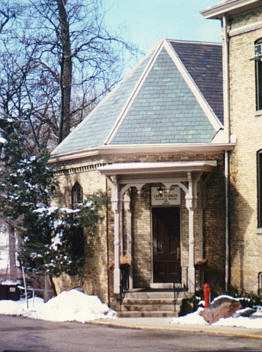
Death on January 12 touched lightly a noble soul, revered in the memory of thousands of Notre Dame men the world over -- Sister Lourdes, C.S.C., 85 years old, the 'coffee urn Sister' of the old kitchen. Her story is a simple one. Coming to Notre Dame in 1878 Sister Lourdes, labored for 49 years in that old kitchen behind Carroll Hall. She had spent in all 57 years -- her entire religious life -- at Notre Dame. In that time she left the campus only two or three times. She set herself to do one thing humbly and generously -- to please God in every thought and word and act. She was assigned to try to please God in the Notre Dame kitchen. Thousands of Notre Dame men, priests, brothers, professors and students -- in every part of the world rise up and call her blessed. Sweetness and kindness itself, she knew only two places in her long life, one was the kitchen near Carroll Hall where her motherly heart and lovely smile dispensed buns and soup and a 'handout' to countless minims and juniors and seniors and the other was the convent chapel.
She did only one thing; she pleased God and Him alone. Only the immortal Father John W. Cavanaugh, who preceded her to Heaven could adequately describe this valiant Notre Dame woman:
To the priests who attended her in her last illness, it seems more fitting to ask the students to pray to her than for her. For 72 hours she lay dying and conscious till the very last. She was just pleasing God. Her only words were ones of thanks for His blessings. She did not have the shadow of even the least worry. If God wanted to take her in 11 seconds, all right; if He wanted her to linger on for 11 years more, all right. She died in Christ's peace with a smiling good-bye to Notre Dame.
May her powerful prayers [and those at the Grotto, her namesake] help Notre Dame and the sons of Notre Dame do the one thing necessary -- to please God in every thing.
Carroll Hall in the west wing of the 1879 Main Building was named after Charles Carroll (1737-1815), the only Catholic and the last surviving signer of the Declaration of Independence. His cousin, Bishop John Carroll (1735-1815), the first Roman Catholic bishop in the United States, ordained Rev. Stephen Theodore Badin, the first priest ordained in the United States. It was Fr. Badin who organized the Mission and Indian Orphanage at Ste. Marie des Lacs -- the future home of Notre Dame.
Sorin had a great admiration for America and its patriots and he honored them by naming halls on campus after them. Brownson and Carroll Halls, housed in the new Main Building, date back to the huge fire. For years the students of the university lived the common life of the dormitory -- dressing on the first floor, studying on the second and sleeping on the third.
In 1943, during the war years, Carroll Hall in the west wing and Brownson Hall in the east wing of the Main Building were vacated. When the Holy Cross Sisters who lived at Notre Dame went back to St. Mary's in 1958, Fr. Hesburgh carried on Sorin's tradition by renaming the building that had served as their convent Brownson Hall.
Later across St. Mary's Lake, Dujarie Institute, built as a Brothers' house of studies in 1906, was vacated by the Brothers when they established Holy Cross College. Its new name, Carroll Hall, was borrowed from old Carroll Hall in the Main Building. It became an undergraduate dorm in 1977 where, it was said, "its isolation from other campus dorms promoted camaraderie between students . . . and a real family atmosphere."
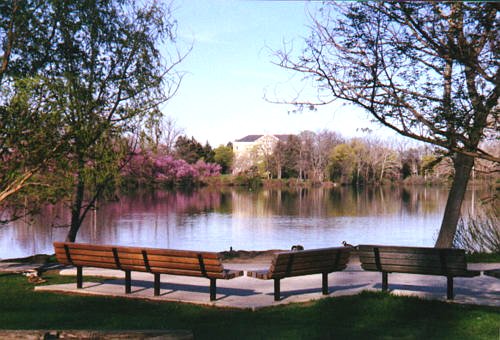
And so, old Carroll Hall -- the domain of Sister Lourdes, the "coffee urn Sister" -- still lives on in memory across St. Mary's Lake near Redbud Island. It is the focal point of this peaceful scene taken from the lakeside benches directly across the road from the path leading to the Grotto.
Sister Bernadette and Sister Lourdes, I was to learn, were not alone in their devotion to their duties at Notre Dame. An account of the Sisters work at Notre Dame under the direction of Mother Ascension, who was with Father Sorin when he died, is mind boggling:
Mother Ascension was gifted with exceptional powers for organization. During her administration the convent at Notre Dame presented the efficiency and productiveness of a small factory. The amount of work accomplished is inconceivable. The Sisters did the baking and cooking for the whole institution. They set type, read proof, folded and sewed by hand the Ave Maria and the Notre Dame Scholastic. They cared for the poultry, milked the cows, and made butter and cheese. They tailored the suits, cassocks, and habits. They laundered and mended the clothing. They wove the table linen, manufactured mattresses and window shades, knit socks and underwear, made the vestments and baked altar bread for Notre Dame and the nearby missions.
Fr. Sorin's will was the will of God to her, and often she followed it at the cost of great personal sacrifice.
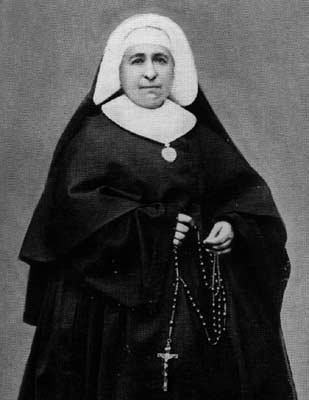
At her funeral, Father Hudson's eulogy captured the essence of Mother Ascension's Christian dedication:
All Christians direct their course to the same Divine End, yet each soul approaches God by its own uncharted path. To attempt to follow Mother Mary of the Ascension on her quest of God is to be lost in labyrinthine ways. Only of this can one feel confident, that at last, after many wanderings, she reached her heart's desire. . . . to the end she was devoted heart and soul to the interests of Notre Dame.(95)
In the same pamphlet honoring the Sisters of the Holy Cross at Notre Dame -- at the time the convent was closed in 1958 -- I found more proof of the Sisters devotion detailed:
Once, many years ago, when Father Matt Walsh was president, he was determined to show the Sisters that their services were highly appreciated. He approached their Superior and made known his desire to do something for the Sisters. What would they like? What could he do to show them that the priests were grateful for the part they were playing in Notre Dame's welfare?
The superior demurred, and said she would ask around among the Sisters for their opinion. When Father Walsh went back to find out their wishes, the superior said to him: 'Father, most of our nuns never get outside very much. Hardly any of them have ever seen Lake Michigan. We thought a little outing up to the Lake might be a happy diversion. But we don't want to cause any . . . .'
Father Walsh told her that was just fine and they would arrange it to suit their convenience.
So one summer day, as many of the nuns as could be spared got into automobiles, some of them for the first time, and were driven off to the blue waters and refreshing breeze of Lake Michigan. Father Walsh, seeing how delighted they were, could only exclaim 'What a very little thing they ask for all their months and years of service!'(96)
I've had more than one priest mention that Notre Dame would not have been here without the dedication and devotion of the Sisters of the Holy Cross to Our Lady and Notre Dame.
It somehow seems appropriate that Notre Dame was blessed with a Sister Bernadette and a Sister Lourdes to grace the Notre Dame Grotto of Lourdes with their presence. And being so like Saint Bernadette, the fact that Sister Lourdes entered life at Notre Dame, on the eve of Saint Bernadette leaving this world somehow adds a special significance to this story.
Sorin's link to the mid 1870s St. Mary's Grotto seemed to be getting stronger and stronger. I wondered what it had looked like and why it had disappeared. Though a few Sisters did remember the Grotto in the glen and one Sister is still living who worked on it, no photographs of it have ever been found. No knowledge of this earlier 1870s St. Mary's Grotto, or a passed on remembrance of it, has survived among any of the elderly Sisters I've come in contact with. A search I shall pursue at another time.